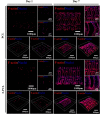Development of 3D-Printed Sulfated Chitosan Modified Bioresorbable Stents for Coronary Artery Disease
- PMID: 32509747
- PMCID: PMC7248363
- DOI: 10.3389/fbioe.2020.00462
Development of 3D-Printed Sulfated Chitosan Modified Bioresorbable Stents for Coronary Artery Disease
Abstract
Bioresorbable polymeric stents have attracted great interest for coronary artery disease because they can provide mechanical support first and then disappear within a desired time period. The conventional manufacturing process is laser cutting, and generally they are fabricated from tubular prototypes produced by injection molding or melt extrusion. The aim of this study is to fabricate and characterize a novel bioresorbable polymeric stent for treatment of coronary artery disease. Polycaprolactone (PCL) is investigated as suitable material for biomedical stents. A rotary 3D printing method is developed to fabricate the polymeric stents. Surface modification of polymeric stent is performed by immobilization of 2-N, 6-O-sulfated chitosan (26SCS). Physical and chemical characterization results showed that the surface microstructure of 3D-pinted PCL stents can be influenced by 26SCS modification, but no significant difference was observed for their mechanical behavior. Biocompatibility assessment results indicated that PCL and S-PCL stents possess good compatibility with blood and cells, and 26SCS modification can enhance cell proliferation. These results suggest that 3D printed PCL stent can be a potential candidate for coronary artery disease by modification of sulfated chitosan (CS).
Keywords: 3D printing; biocompatibility; bioresorbable stent; mechanical property; sulfated chitosan.
Copyright © 2020 Qiu, Jiang, Yan, Jiao and Wang.
Figures












Similar articles
-
The Development of Design and Manufacture Techniques for Bioresorbable Coronary Artery Stents.Micromachines (Basel). 2021 Aug 20;12(8):990. doi: 10.3390/mi12080990. Micromachines (Basel). 2021. PMID: 34442612 Free PMC article. Review.
-
3D Printing of Polymeric Bioresorbable Stents: A Strategy to Improve Both Cellular Compatibility and Mechanical Properties.Polymers (Basel). 2022 Mar 9;14(6):1099. doi: 10.3390/polym14061099. Polymers (Basel). 2022. PMID: 35335430 Free PMC article. Review.
-
3D-Printed PCL/PLA Composite Stents: Towards a New Solution to Cardiovascular Problems.Materials (Basel). 2018 Sep 11;11(9):1679. doi: 10.3390/ma11091679. Materials (Basel). 2018. PMID: 30208592 Free PMC article.
-
Advances in the development of biodegradable coronary stents: A translational perspective.Mater Today Bio. 2022 Jul 19;16:100368. doi: 10.1016/j.mtbio.2022.100368. eCollection 2022 Dec. Mater Today Bio. 2022. PMID: 35937578 Free PMC article. Review.
-
Development of 3D Printed Biodegradable, Entirely X-ray Visible Stents for Rabbit Carotid Artery Implantation.Adv Healthc Mater. 2024 Jun;13(15):e2304293. doi: 10.1002/adhm.202304293. Epub 2024 Mar 11. Adv Healthc Mater. 2024. PMID: 38444200
Cited by
-
An Overview of the Molecular Mechanisms Associated with Myocardial Ischemic Injury: State of the Art and Translational Perspectives.Cells. 2022 Mar 30;11(7):1165. doi: 10.3390/cells11071165. Cells. 2022. PMID: 35406729 Free PMC article. Review.
-
A Review on Manufacturing and Post-Processing Technology of Vascular Stents.Micromachines (Basel). 2022 Jan 16;13(1):140. doi: 10.3390/mi13010140. Micromachines (Basel). 2022. PMID: 35056305 Free PMC article. Review.
-
Bioinspired chitosan based functionalization of biomedical implant surfaces for enhanced hemocompatibility, antioxidation and anticoagulation potential: an in silico and in vitro study.RSC Adv. 2024 Jul 1;14(29):20691-20713. doi: 10.1039/d4ra00796d. eCollection 2024 Jun 27. RSC Adv. 2024. PMID: 38952927 Free PMC article.
-
Application of chitosan in fruit preservation: A review.Food Chem X. 2024 Jun 22;23:101589. doi: 10.1016/j.fochx.2024.101589. eCollection 2024 Oct 30. Food Chem X. 2024. PMID: 39036472 Free PMC article. Review.
-
219Three-dimensional printing as a cutting-edge, versatile and personalizable vascular stent manufacturing procedure: Toward tailor-made medical devices.Int J Bioprint. 2023 Jan 9;9(2):664. doi: 10.18063/ijb.v9i2.664. eCollection 2023. Int J Bioprint. 2023. PMID: 37065659 Free PMC article.
References
-
- Demir A. G., Previtali B. (2017). Additive manufacturing of cardiovascular cocr stents by selective laser melting. Mater. Des. 119 338–350. 10.1016/j.matdes.2017.01.091 - DOI
-
- Demir A. G., Previtali B., Colombo D., Ge Q., Biffi C. A. (2012). Fiber laser micromachining of magnesium alloy tubes for biocompatible and biodegradable cardiovascular stents. Fiber lasers ix: technology, systems, and applications. Int. Soc. Opt. Photon. 8237:823730 10.1117/12.910131 - DOI
LinkOut - more resources
Full Text Sources

